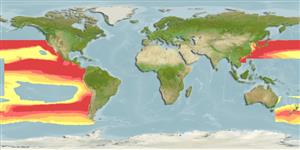Common names from other countries
>
Stomiiformes (Lightfishes and dragonfishes) >
Stomiidae (Barbeled dragonfishes) > Idiacanthinae
Etymology: Idiacanthus: Greek, idia = own privative + Greek, akantha = thorn (Ref. 45335); antrostomus: antrostomus meaning cavern mouth (Ref. 4525).
More on author: Gilbert.
Environment: milieu / climate zone / depth range / distribution range
Ecologia
marinhas batipelágico; intervalo de profundidade 0 - 1103 m (Ref. 58018). Deep-water; 42°N -
Eastern Pacific: throughout most of the tropic and temperate waters, both north and south of the equator.
Tamanho / Peso / Idade
Maturity: Lm ? range ? - ? cm
Max length : 33.0 cm TL macho/indeterminado; (Ref. 4525); 38.0 cm TL (female)
Descrição breve
Chaves de identificação | Morfologia | Morfometria
Espinhos dorsais (total) : 0; Raios dorsais moles (total) : 54 - 66; Espinhos anais: 0; Raios anais moles: 28 - 43; Vértebras: 81 - 85.
Mesopelagic species (Ref. 559). Migrates to the surface at night and return to the depths at dawn. Feed mainly on small fishes and crustaceans (Ref. 4525). Oviparous, with planktonic eggs and larvae (Ref. 35926). Exhibit extreme sexual dimorphism, with larvoid males (Ref. 35926).
Life cycle and mating behavior
Maturities | Reprodução | Spawnings | Egg(s) | Fecundities | Larvas
Eschmeyer, W.N., E.S. Herald and H. Hammann, 1983. A field guide to Pacific coast fishes of North America. Boston (MA, USA): Houghton Mifflin Company. xii+336 p. (Ref. 2850)
Categoria na Lista Vermelha da IUCN (Ref. 130435)
CITES (Ref. 128078)
Not Evaluated
Ameaça para o homem
Harmless
Utilização humana
Ferramentas
Relatórios especiais
Descarregue XML
Fontes da internet
Estimates based on models
Preferred temperature (Ref.
115969): 1 - 22.5, mean 11.7 (based on 216 cells).
Phylogenetic diversity index (Ref.
82804): PD
50 = 0.6250 [Uniqueness, from 0.5 = low to 2.0 = high].
Bayesian length-weight: a=0.00389 (0.00180 - 0.00842), b=3.12 (2.94 - 3.30), in cm Total Length, based on all LWR estimates for this body shape (Ref.
93245).
Nível Trófico (Ref.
69278): 3.8 ±0.60 se; based on food items.
Resiliência (Ref.
120179): Elevada, tempo mínimo de duplicação da população menor que 15 meses (Preliminary K or Fecundity.).
Fishing Vulnerability (Ref.
59153): Low to moderate vulnerability (26 of 100).
